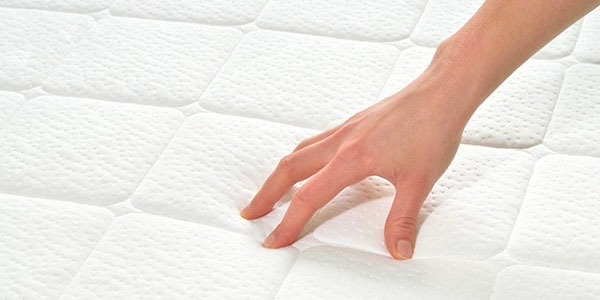How to Tell When You Should Replace a Mattress

When to Replace Your Mattress
The average adult spends 26 years sleeping and 7 years trying to get to sleep in their lifetime. In between reading a book, warm baths and meditation exercises, have you considered that the cause for your tossing and turning may be your mattress?
How Often Should You Replace Your Mattress?
You probably spend a decent amount of time daydreaming about your bed during the day, but have you taken the time to think about when the last time you replaced your mattress was?

“We suggest that every seven years you evaluate your mattress for comfort and support. It isn’t just the wear and tear on your sleep surface, it is your own body and personal preferences and needs that may have changed.”
Mary Helen Rogers | Better Sleep Council
Average Life Span by Mattress Type
Each type of mattress and specific manufacturer has a different life span, but it is important to keep in mind that each mattress will wear at a different rate. Better Sleep Council’s Mary Helen Rogers shares, “Your unique size and weight in conjunction with factors such as if you sleep alone, with a partner or with pets – all impact the life span of your mattress.”
Innerspring
An innerspring mattress is the most common type of mattress because of its affordability and stability. The coils inside your mattress are the most important element when considering life span. A high-quality innerspring has thick coils that depreciate slowly. But if you have little monkeys jumping on your bed, or your mattress has absorbed a greater amount of weight, they will break down quicker.
For a slightly softer option that still offers the support of the innerspring, you can invest in a pillow top pad or mattress.
Average Life Span: 10 years
Memory Foam
Ironically, a memory foam loses “memory” quicker than other types of mattresses. As your memory foam ages, it becomes softer and body impression development is more common. It is important to check your warranty on this mattress type because many do not cover softening or sagging.
If you run hot, some brands of memory foam offer gel formulas which help to redirect heat.
Average Life Span: 7-10 years
Waterbed
A more outdated, but still viable, option to catch your zzz’s on is a water bed. Waterbeds have decreased in popularity due to high maintenance to keep them running, but the warm water mattress may be a good choice to help relieve pain in your back and legs. In order to keep them running properly, you must add waterbed conditioner annually and fix any leaks that occur from time to time.
Average Life Span: 10-20 years
All-Natural Latex
Latex mattresses are becoming more popular due to their eco-friendliness, since they’re made with 100% natural latex. This type of mattress holds less heat and can offer relief for consumers with chronic back pain. While the price tag may be higher than other mattresses, they have a decent life span and offer various options for firmness and thickness.
Average Life Span: 12-20 years
Adjustable Bases
A great addition to any mattress, adjustable bases have their own life span as well. An adjustable box spring for your mattress can offer many benefits for consumers of any age. They are known to help with many symptoms, such as:
- Circulation issues and leg swelling
- Acid reflux, heartburn and problems with digestion
- Back pain and arthritis
- Sleep apnea, snoring and asthma
- Decreased mobility due to age, illness or disability.
The trick is to make sure that your base is safe to use with the type of mattress you have. And you should be prepared for a higher price tag than a traditional box spring.
Average Life Span: Up to 10 years, but can vary due to electrical components that may need replacing.

5 Signs You Need a New Mattress
Don’t make the mistake of simply following your mattress’s warranty as a guide for when to replace it, there are many other factors that could come in to play well before the warranty says its time. These are a few of the biggest ways to tell if your mattress is worn out.
1. Your Mattress is More Than 10 Years Old
This one is self-explanatory. If you’ve been sleeping on the same mattress since college even though graduation was a decade ago, it might be time to upgrade. One helpful way to remember when you bought your mattress is by writing the purchase date on the label.
2. Your Mattress Shows the Shape of Your Body
Whether your mattress has coils or is a memory foam, gel or pillow top, it can start to break down and sag. The longer you wait to replace it, the worse it will get. Your mattress can also lose shape more quickly if you’ve experienced a significant change in body weight.
3. Your Body is Telling You It’s Time
Starting your day with aches, stiffness or numbness are glaring signs that it’s time to replace your mattress. As your bed loses its ability to provide the proper support, your body suffers. If you notice your aches and pains subsiding as you start moving around for the day, it could be that your bed is the culprit of your soreness.

“It’s not just the age of your mattress that matters. As we age, our bodies become more sensitive to pressure. That means sleeping on a lumpy, bumpy or sagging mattress when you’re older is more likely to lead to tossing and turning throughout the night. In other words, you might need to consider the state of your mattress more frequently as you age.”
Mary Helen Rogers | Better Sleep Council
4. You’re Having Problems With Asthma, Allergies or Sleep Apnea
Not in the midst of peak allergy season, you’ve recently vacuumed your mattress, but your allergies are still acting up? If your symptoms seem particularly bad in the morning or evening, it could mean your mattress is covered in dust mites, molds or pet dander and you should replace it.
If your sleep apnea seems to be getting worse, this could mean you need an adjustable base bed to sleep at an angle and help the air pass more easily through your airways for a more restful night’s sleep.
5. You’ve Added a Co-Sleeper
If you have a new significant other or child sleeping with you every night, your bed may not offer satisfactory sleep conditions. You will want to research a solution that will work for everyone and support the added weight. This can mean a new mattress, larger mattress or both.

“Evaluate the condition of your mattress for comfort and support twice a year when you adjust your clocks for seasonal time changes. You’re already thinking about gaining or losing sleep, so use this to jog your memory.”
Mary Helen Rogers | Better Sleep Council

Things to Consider When Buying a New Mattress
If you’ve identified one or more of these signs, then it might be time to grab your co-sleeper and head to the mattress store.

“There are a lot of mattress choices out there and it’s important to know that they’re not one size fits all. But shopping for a new bed system doesn’t have to be so confusing. Read our tips for choosing a mattress and take the Better Bed Quizzz™ to help set the priorities that are most important to you.”
Mary Helen Rogers | Better Sleep Council
Check Your Box Spring
If your mattress is on the newer side, but you’re still having issues with comfortable sleep, you might consider checking your box spring. The support that your mattress provides can be significantly affected by what’s supporting it underneath. A bed frame alone without center support can cause your mattress to sag. A broken or worn box spring can also affect the shape and support of your bed.
Your box spring should last you about the same length as your mattress, between 8-10 years. But if you didn’t buy your mattress and box spring together or it’s damaged in some way, it may be time to invest a new one.
Don’t Forget About Your Pillows
How often should you be replacing your pillows? According to the National Sleep Foundation, you should be replacing them every one to two years. After nightly use, your pillow can absorb dead hair, skin cells and oils, as well as hold on to many allergens that can cause your allergies and asthma to go haywire.
Washing your pillow every six months can help, but replacing your pillow regularly will guarantee a better night’s sleep.
Figure Out What to Do With Your Old Mattress
If you think it’s time to toss your old mattress and box spring, there are some recycling and donation options if you want to keep it out of the landfills and reduce your carbon footprint. Make sure to follow our comprehensive mattress disposal guide to ensure you are properly getting rid of these items.
Ready to part ways with your mattress? Learn how to cut it up for easy disposal!
Tips for Extending the Life Span of Your Mattress
Once you’ve made the investment of purchasing a new mattress, you’ll want to get the most bang for your buck. By following these simple steps, you can help prolong the health of your mattress (and your own comfort).
Clean Your Mattress
Vacuum your mattress with your vacuum cleaner’s upholstery attachment about once a month, and steam clean it every 6 months. Keeping your mattress free of dust, crumbs and other small particles can help with its longevity.
Wash Your Sheets
Since our bodies produce a lot of oil, dead skin cells and hair, it’s a good idea to wash your bedding once a week (or more!) if needed. Having clean bedding will help protect not only your mattress, but also your overall health.
Use a Mattress Pad or Cover
Covering your mattress with a protective cover or pad can assist in saving your mattress from any spills, fluids or oils that soak through your sheets. If you have a pet or small child sleeping with you, making sure your cover is waterproof is key. Remember to toss the cover in the washer every time you wash your sheets.
Rotate Your Mattress
By rotating your mattress regularly, your weight will be dispersed more evenly over time, which lessens the chance that a body imprint will occur. This maintenance step is especially important if your co-sleeper is heavier than you are.



